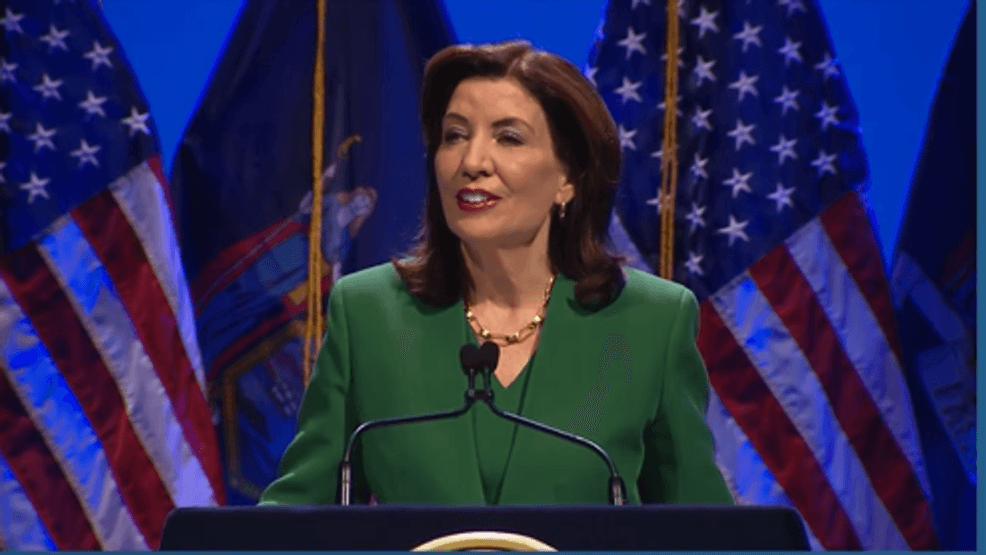Gov.’s State-of-the-State Address Promotes Rail, Climate, Housing, Childcare Funding Goals
ALBANY—In advance of her 2025 State of the State address on Jan. 14, New York Gov. Kathy Hochul announced a series of funding initiatives geared at addressing the housing shortage and affordability crisis, improving Metro North rail service in the Hudson Valley region and child care facility construction.
At press time, the governor released four separate announcements related to her upcoming State of the State address. The most expansive initiative involves new laws and policies and $100 million in funding geared to make homeownership more affordable and accessible in New York State. Three of her proposals would have benefits for the construction and building industries.
Housing Reforms and Targeted Funding – one initiative focuses on disincentivizing institutional investors from buying up one- and two-family homes throughout the state. She explained that hedge funds private equity firms and other institutional investors, have played an increasingly significant role in the single-family and two-family housing market in recent years

These large entities can often outbid prospective homeowners with all cash offers and fast track their ownership by waiving inspections, appraisals and other common prerequisites that traditional homebuyers cannot. The rise in digital technologies have further paved the way for these entities to purchase single-family and two-family homes, allowing them to monitor real estate markets and move quickly to identify, evaluate and make offers on properties that fit their criteria. Nationally, private equity firms own more than 500,000 homes. According to some estimates, private equity firms are expected to own up to 40% of the single-family rental market by 2030.
To help level the playing field and increase the opportunities for everyday individuals and families to purchase a home, Gov. Hochul is proposing legislation to disincentivize large investment entities from buying single- and two-family homes en masse; it will require a 75-day waiting period for institutional investors to make an offer on one- or two-family homes.
Additionally, the governor will propose reducing the opportunity for institutional investors to take advantage of tax code provisions that make these investments in single- and two-family homes more lucrative by denying these entities the ability to utilize the interest deductions, depreciation deductions and other expenses associated with the ownership of these properties. If these measures are approved by the Legislature, New York State would be creating a nation-leading model that disincentivizes institutional investors from buying up homes, she said.
Provide Starter Home Innovation Funding – to address the shortage of traditional smaller starter homes, Gov. Hochul has proposed $50 million in capital funding to incentivize the building of more starter homes, including innovative approaches to homebuilding such as the use of factory-built and modular development.
First-Time Homebuyers Down Payment Assistance – the governor also announced she will provide $50 million in new state funding to support New Yorkers struggling to save for down payments and help more individuals and families achieve the dream of homeownership.
Create an Affordable Homebuyer Tax Incentive – she is also proposing an affordable homebuyer property tax incentive with a local opt-in for homes built with assistance from governmental entities, nonprofits, land banks or community land trusts, and sold to low- and moderate-income homebuyers.
Strengthen Laws to Combat Home Appraisal Discrimination – in her State of the State address, the governor will propose a suite of actions to make discriminatory appraisal practices unlawful, enforce anti-discrimination principles in appraisals and diversify the appraiser workforce.
Her housing initiatives make up the governor’s fourth announced proposal to be included in her State of the State address. Her latest housing initiatives build on the governor’s $25 billion, five-year housing plan to create or preserve 100,000 affordable homes statewide. State officials noted that New York State has reached the milestone of creating 50,000 affordable homes within two years.
More Than $100 Million for Childcare Construction, Renovation Projects – in her State of the State address, the governor will propose a $110-million Child Care Construction Fund to build new childcare facilities and repair existing sites. This fund will distribute grant money to child care providers to construct new facilities or repair existing facilities, with the goal of creating new safe sites for kids and providers. Grant funding will be available to non-profit or for-profit childcare centers, as well as to school age childcare programs, incentivizing the creation of new childcare sites.
The governor will also propose establishing a “substitute pool” to expand the childcare workforce, helping providers find trusted, vetted professionals to quickly step in and keep classrooms open. Finally, the she will launch the New York Coalition for Child Care to bring together business leaders, labor unions, service providers and tax experts to identify a sustainable path forward for achieving universal childcare.
Upgrades to Metro North Rail Service – earlier this month, the governor proposed what she termed as a major investment in Hudson Valley rail service that would increase capacity, reduce delays, improve safety and cut potential travel times by up to 15 minutes each way for certain trips, as well as shorten “super-express” Metro-North Hudson Line trips to less than 90 minutes. The proposal, which did not include cost estimates for the various initiatives, includes planning, evaluation and design for a set of rail infrastructure capital improvements between New York City and Poughkeepsie, including projects such as a second track at Spuyten Duyvil, interlocking, signaling and trackwork at Croton Harmon, and capacity improvements at Poughkeepsie Yard. In addition, the Metropolitan Transportation Authority (MTA) will execute a signaling redesign near Yonkers and climate resilience investments in the most vulnerable and highest ridership segments of the Hudson Line.
